Bridgestone Bundle
How did a Japanese company become the world's largest tire manufacturer?
Discover the fascinating Bridgestone SWOT Analysis, a journey that began with a simple idea: producing tires in Japan. Founded in 1931 by Shojiro Ishibashi, the Bridgestone company has evolved from a domestic producer to a global powerhouse. Learn about the strategic decisions and innovations that propelled this Japanese tire manufacturer to international prominence.
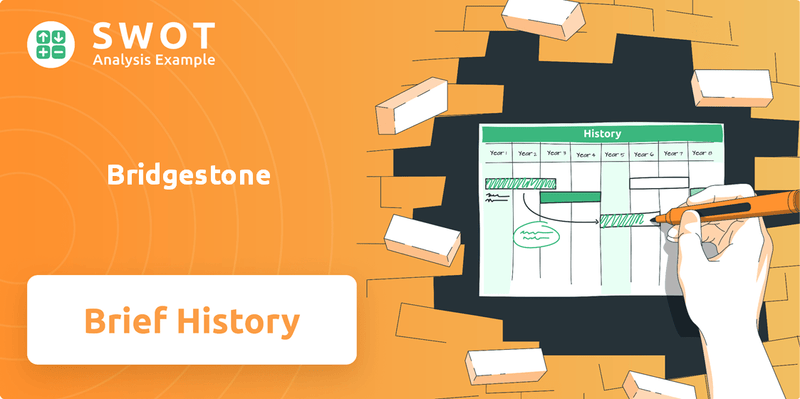
From its origins, the Bridgestone history is marked by significant milestones and a commitment to quality. This brief history of Bridgestone tires explores the Bridgestone founder's vision and the company's early years, revealing how it navigated challenges and capitalized on opportunities. Explore Bridgestone's expansion globally and its key milestones, understanding its impact on the tire industry.
What is the Bridgestone Founding Story?
The story of the Bridgestone company begins in Japan, with a vision to revolutionize the tire industry. Founded by Shojiro Ishibashi, the company's roots are deeply intertwined with innovation and a determination to build a global presence.
Bridgestone's history is a testament to strategic foresight and entrepreneurial spirit. From its humble beginnings to its current status as a global leader, the company has consistently pushed boundaries.
Shojiro Ishibashi established Bridgestone Tire Co., Ltd. on March 1, 1931, in Kurume, Japan. Ishibashi's innovative approach to business and his understanding of the market were crucial in the company's early success.
- Ishibashi's family business in clothing, particularly tabi socks, provided the initial capital.
- He innovated Jika-tabi, work shoes with rubber soles, laying the groundwork for his tire venture.
- The primary goal was to establish a domestic tire industry in Japan, reducing reliance on foreign technology.
- The first tire was produced on April 9, 1930, before the official company launch, marking the beginning of the company's focus on tire manufacturing.
The name 'Bridgestone' is a direct translation of Shojiro Ishibashi's surname, reflecting his ambition for the company's global reach. Early challenges in technology, production, and sales were overcome through Ishibashi's business acumen. His strategy of expanding during economic downturns was key to the company's initial growth. The company's commitment to innovation and strategic expansion has been central to its longevity.
Bridgestone SWOT Analysis
- Complete SWOT Breakdown
- Fully Customizable
- Editable in Excel & Word
- Professional Formatting
- Investor-Ready Format
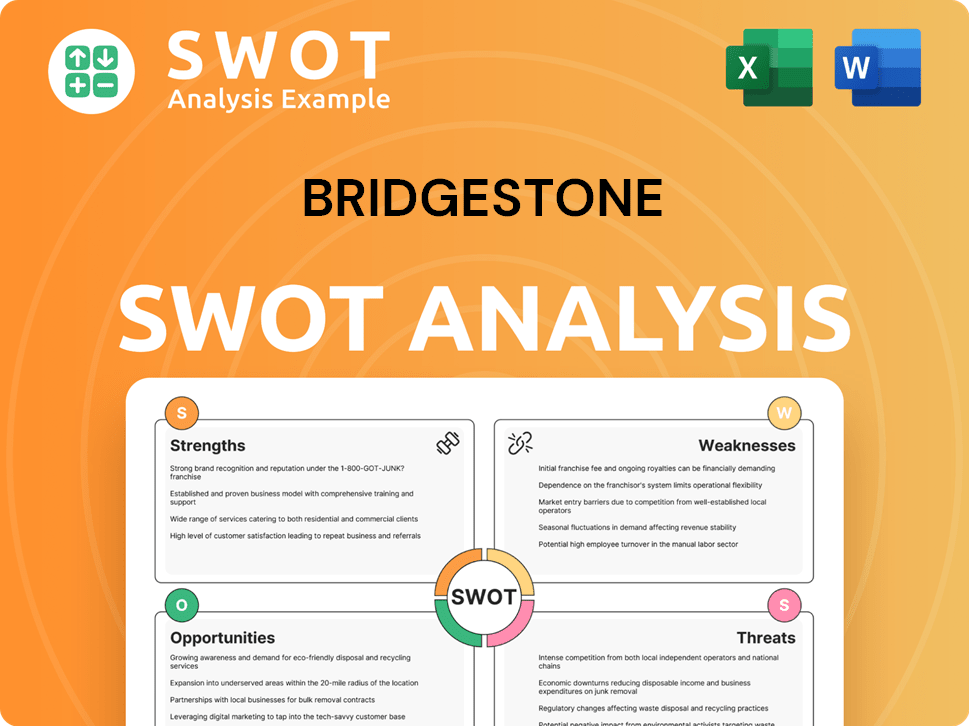
What Drove the Early Growth of Bridgestone?
The early years of the Bridgestone company were marked by rapid growth and diversification. From its inception, the Japanese tire manufacturer quickly expanded its product offerings and manufacturing capabilities. This period laid the foundation for its future as a global leader in the tire industry.
Full-fledged tire production began in 1934 at the Kurume Plant. In 1935, the company diversified into golf ball production. By 1937, the head office moved to Tokyo, signaling growth. The company also started producing V-belts, rubber hoses, and vibration-damping rubber.
World War II brought significant challenges, including the destruction of the Tokyo headquarters. However, the undamaged plants in Kurume and Yokohama allowed for a quick resumption of production. In 1951, the company reverted to the name Bridgestone Tire Co., Ltd. They became the first in Japan to sell rayon cord tires.
By 1953, Bridgestone's sales exceeded 10 billion yen, establishing it as the leader in the Japanese tire industry. The introduction of nylon tires in 1959 further solidified their market position. These milestones highlight the company's rapid growth and success in the early years.
The 1960s saw significant overseas expansion, including a new plant in Tokyo in 1960. Bridgestone was listed on the Tokyo and Osaka stock exchanges in 1961. The company established Bridgestone Tire Company of America in 1967. A pivotal move was the 1988 acquisition of Firestone Tire & Rubber Company for $2.6 billion.
Bridgestone PESTLE Analysis
- Covers All 6 PESTLE Categories
- No Research Needed – Save Hours of Work
- Built by Experts, Trusted by Consultants
- Instant Download, Ready to Use
- 100% Editable, Fully Customizable
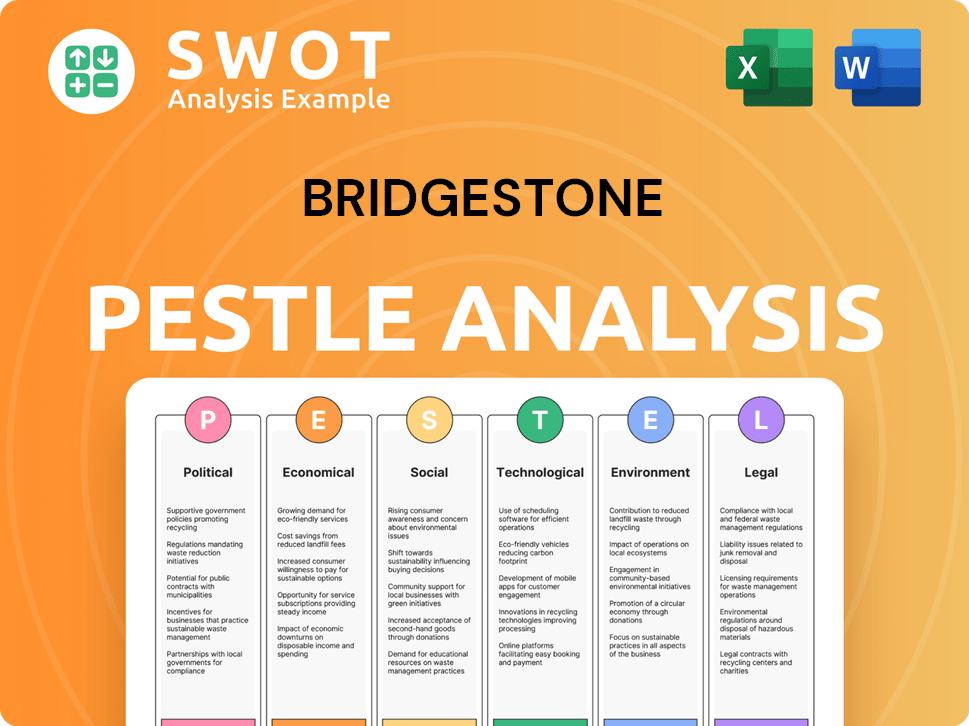
What are the key Milestones in Bridgestone history?
The Bridgestone history is marked by significant achievements and strategic moves that have shaped it into a global leader. From its origins as a Japanese tire manufacturer to its expansion worldwide, the company has consistently adapted and innovated.
| Year | Milestone |
|---|---|
| 1931 | Shojiro Ishibashi founded the company, initially named after his surname, which translates to 'stone bridge' in English. |
| 1962 | The company developed Japan's first steel radials for trucks and buses, known as Steel Rib tires. |
| 1968 | Awarded the prestigious Deming Prize for excellence in quality management, demonstrating its commitment to quality. |
| 1988 | Acquired Firestone Tire & Rubber Company for $2.6 billion, becoming the world's largest tire and rubber company. |
| 2007 | Acquired Bandag, Incorporated, a tire retreader, expanding its offerings in the truck and bus tire market. |
Innovation has been central to the Bridgestone company's success, with advancements in tire technology. The company has consistently invested in research and development, leading to the creation of high-performance and fuel-efficient tires.
In 1962, the company introduced Japan's first steel radials for trucks and buses, setting a new standard in tire durability and performance. This innovation improved the lifespan and efficiency of commercial vehicles.
Following the success of its commercial tires, the company developed Japan's first passenger vehicle radials in 1964. This expansion into the passenger vehicle market broadened its customer base.
Launched in 1979, the POTENZA radial tire line represented a significant advancement in high-performance tires. These tires were designed for superior grip and handling.
The company has also innovated in winter tire technology, developing tires with enhanced grip for improved safety in challenging weather conditions. These tires provide better control in snow and ice.
The company has focused on developing tires that improve fuel efficiency, contributing to environmental sustainability and cost savings for consumers. These tires reduce rolling resistance.
The company's run-flat technology allows drivers to continue driving even after a puncture, enhancing safety and convenience. This technology provides added peace of mind on the road.
Despite its successes, the Bridgestone company has faced challenges, including economic pressures and raw material supply issues. The company has needed to adapt to competitive pricing and changing market dynamics.
The tire industry is highly competitive, with constant pressure to offer competitive pricing and maintain market share. The company faces competition from both established and emerging tire manufacturers.
The company is vulnerable to fluctuations in the supply and cost of raw materials, such as natural rubber, which can impact production costs. Supply chain disruptions pose a constant risk.
Global economic instability and geopolitical events can affect demand for tires, currency exchange rates, and overall business performance. Economic downturns can reduce consumer spending on tires.
The increasing popularity of Chinese electric vehicles and the surge in low-end tire imports, particularly in Europe and Latin America, are reshaping the tire market and affecting profit margins. This shift demands strategic adaptation.
Occasionally, product failures can damage the company's reputation and lead to increased warranty costs. Addressing and preventing these issues is critical for maintaining customer trust.
Unstable international political conditions and sudden political or economic changes can disrupt operations and affect market access. Geopolitical risks require proactive risk management strategies.
Bridgestone Business Model Canvas
- Complete 9-Block Business Model Canvas
- Effortlessly Communicate Your Business Strategy
- Investor-Ready BMC Format
- 100% Editable and Customizable
- Clear and Structured Layout
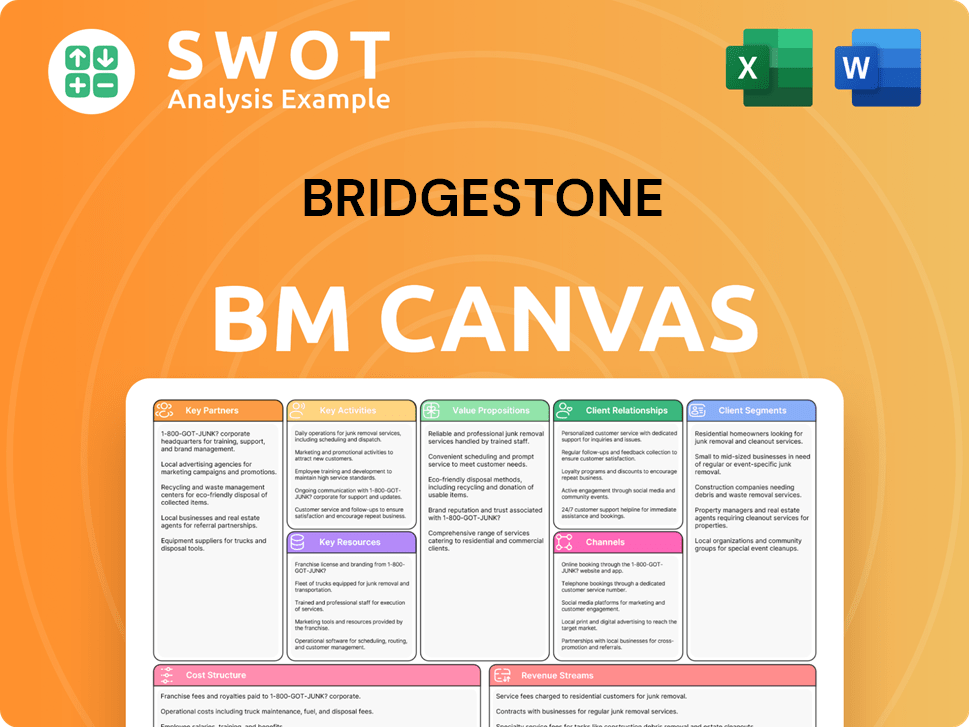
What is the Timeline of Key Events for Bridgestone?
The Bridgestone company, a prominent Japanese tire manufacturer, has a rich history marked by significant milestones and strategic expansions. From its humble beginnings in 1931, when Shojiro Ishibashi established Bridgestone Tire Co., Ltd., to its current global presence, the company has consistently demonstrated innovation and growth. The acquisition of Firestone in 1988 marked a pivotal moment, solidifying Bridgestone's position as a global leader in the tire industry. Further diversification came with the 2020 acquisition of TomTom Telematics, now Webfleet Solutions, highlighting the company's commitment to technological advancement and its broader vision for mobility solutions. This Bridgestone history showcases the company's evolution and its adaptability to changing market dynamics.
| Year | Key Event |
|---|---|
| 1930 | The first Bridgestone tire was produced by the 'Tabi' Socks Tire Division. |
| 1931 | Shojiro Ishibashi established Bridgestone Tire Co., Ltd. in Kurume, Fukuoka, Japan. |
| 1953 | Sales surpassed 10 billion yen, making Bridgestone the top tire industry leader in Japan. |
| 1967 | Bridgestone Tire Company of America Ltd. was established as the U.S. sales headquarters. |
| 1988 | Bridgestone acquired The Firestone Tire & Rubber Company for $2.6 billion. |
| 2007 | Bridgestone acquired Bandag, Incorporated, a tire retreader. |
| 2020 | Acquired TomTom Telematics (now Webfleet Solutions), a digital fleet solutions provider. |
Bridgestone's '2030 Long Term Strategic Aspiration' sets ambitious goals, including a global Return on Invested Capital (ROIC) exceeding 10%. This strategic vision focuses on strengthening the company's core business and improving operational efficiency. The company aims to enhance 'management quality, working & business quality' to achieve these targets.
In the first quarter of 2025, Bridgestone reported global revenue of approximately $7.3 billion. North America significantly contributed to this revenue, generating $3 billion. The company's adjusted operating profit for 1Q 2025 was around $767 million. Bridgestone is also expanding its 'ultra-HRD' tire offerings, which accounted for 13% of sales in the replacement channel in North America and Europe during 1Q 2025.
Bridgestone is leveraging its ENLITEN technology to expand its original equipment fitment base, focusing on value creation through customization. The company is committed to sustainable mobility, aiming to improve how people move, live, work, and play. This commitment aligns with its founding vision of serving society with superior quality.
Bridgestone plans to maximize the utilization of existing buildings and equipment in the United States. The company intends to increase output by approximately two million units gradually from the start of 2025, with the building structure completed by the end of 2027. This expansion reflects Bridgestone's strategic focus on operational efficiency and market growth. For a deeper dive into the company's origins, consider reading this article about the Bridgestone company origins.
Bridgestone Porter's Five Forces Analysis
- Covers All 5 Competitive Forces in Detail
- Structured for Consultants, Students, and Founders
- 100% Editable in Microsoft Word & Excel
- Instant Digital Download – Use Immediately
- Compatible with Mac & PC – Fully Unlocked
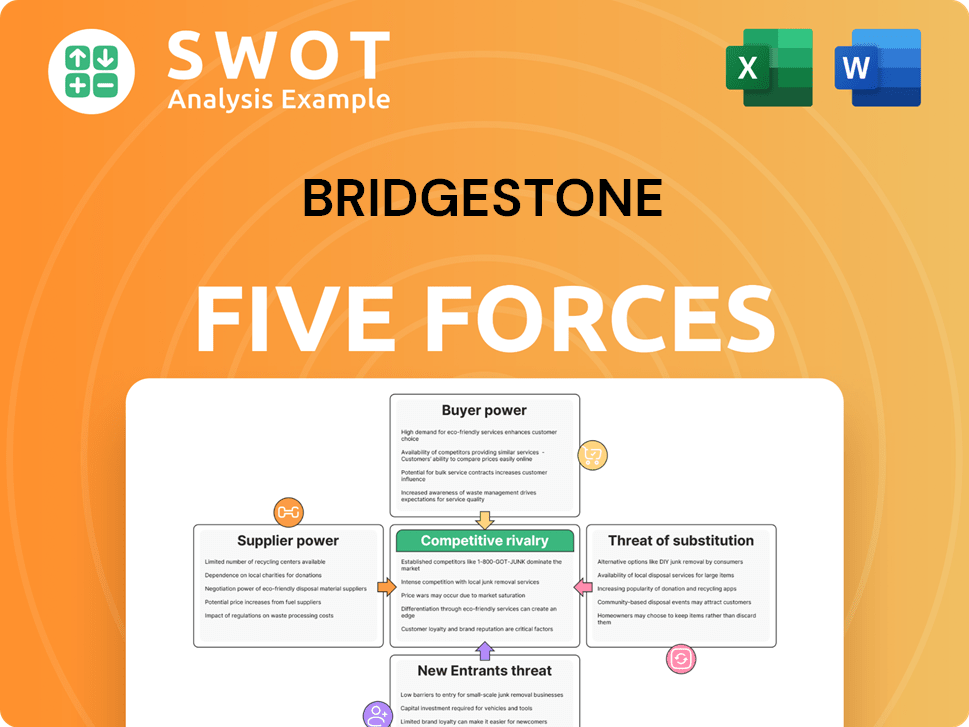
Related Blogs
- What is Competitive Landscape of Bridgestone Company?
- What is Growth Strategy and Future Prospects of Bridgestone Company?
- How Does Bridgestone Company Work?
- What is Sales and Marketing Strategy of Bridgestone Company?
- What is Brief History of Bridgestone Company?
- Who Owns Bridgestone Company?
- What is Customer Demographics and Target Market of Bridgestone Company?
Disclaimer
All information, articles, and product details provided on this website are for general informational and educational purposes only. We do not claim any ownership over, nor do we intend to infringe upon, any trademarks, copyrights, logos, brand names, or other intellectual property mentioned or depicted on this site. Such intellectual property remains the property of its respective owners, and any references here are made solely for identification or informational purposes, without implying any affiliation, endorsement, or partnership.
We make no representations or warranties, express or implied, regarding the accuracy, completeness, or suitability of any content or products presented. Nothing on this website should be construed as legal, tax, investment, financial, medical, or other professional advice. In addition, no part of this site—including articles or product references—constitutes a solicitation, recommendation, endorsement, advertisement, or offer to buy or sell any securities, franchises, or other financial instruments, particularly in jurisdictions where such activity would be unlawful.
All content is of a general nature and may not address the specific circumstances of any individual or entity. It is not a substitute for professional advice or services. Any actions you take based on the information provided here are strictly at your own risk. You accept full responsibility for any decisions or outcomes arising from your use of this website and agree to release us from any liability in connection with your use of, or reliance upon, the content or products found herein.